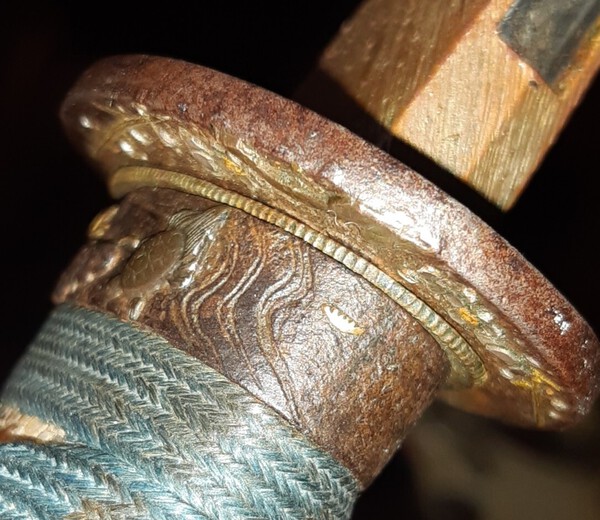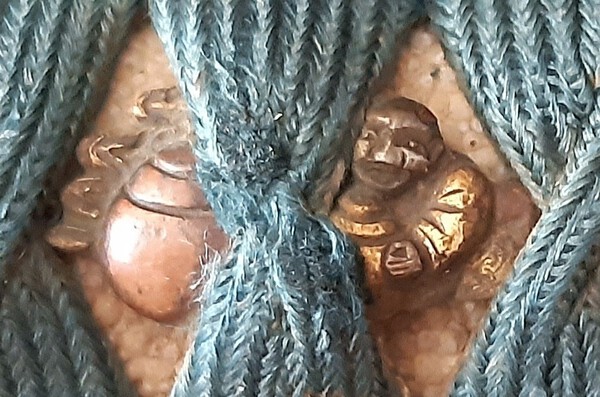
Janrudolph
Members-
Posts
252 -
Joined
-
Last visited
Content Type
Profiles
Forums
Events
Store
Downloads
Gallery
Everything posted by Janrudolph
-
There's no doubt George has it 100% correct in his statement (thanks George), but I can't say the same for the accuracy of the depiction on the kashira. The kashiramaker must have had Roberts' Book of Birds open on the wrong page... Johan
-
Brian, my apologies - I worded my request for info wrongly. I should have said "Those lines that seem like eddies, engraved above, to the rear of the minogame turtle, seem to me to be the edge of the sea." The turtle has already been identified as minogame when the tanto blade plus fittings was discussed in the nihonto board a few days ago. But thanks for coming in again. I get a lot of satisfaction from knowing that the various "characters" or themes portrayed by the artists/craftsmen on our Japanese swords all carry some message or serve as a reminder of the deep cultural or traditional values and beliefs of the Japanese. I would conversely have been less impressed if the tokens on the swords had been generic or randomly chosen as a sales gimmick in olden days. Please don't tell me that the Japanese craftsmen of old sometimes did this! It would blow my bubble! I think it is common on low-level swords today, is it not? I'm sure you can get any old picture on a tsuba or fuchikashira. Some do tell a story though: let me quickly bring this one in, about my Longquan katana with a beautiful cormorant neck blade, plus hamon and hada, sporting three horses on each side of the tsuba, as well as on the fuchikashira. It was made about 20 years ago on order for a SA veterinarian who loved doing endurance horse trials. I got it from him. But I digress..... Anymore suggestions as to the "combs" / "boats" or whatever? Thanks. Johan
-
Please see (amongst others) three pics of the fuchi, showing two more of the golden "combs". Those swirls engraved above, to the rear of the turtle, seem to me to be the edge of the sea. If that is the case, the "comb" might be a boat with some masts. But these are guesses. These fittings have obviously seen a lot of wear, if not lack of care. But they are genuine old nihonto and I hold them in esteem. The ito seems to be silk. I must assume the gold colour is gold foil, rubbed onto the design. I am also assuming the fuchi band/collar started off as a simple flat strip of iron, and the pine design crafted as a separate piece of iron and then inletted into the collar. The turtle itself seems to be some coppery metal, not iron. (I'm expecting some flak soon because of my determination in trying to see things in the artwork that don't deserve all the attention.....!) Johan.
-
Dale, George, Grev, Bob & Jean, all your kind inputs are valuable to me. I know I am not the right person to judge or assess your suggestions, as I have soooo little hands-on experience with nihonto. But my gut feeling tends towards the night heron. And I have accepted the ID of the bamboo and pine. I'm still curious however about those two little golden comb-shaped objects situated close to the bamboo leaves....? I tend to file the "generic bird" idea at the bottom of the pile, for now..... why? Well, in my mind's eye I see these hundreds of mid-level makers of fuchikashira plying their trade in the ubiquitous "Edo period". They were working in a competitive market and were intent on winning custom. How better to do this than using real birds to highlight the traditions and beliefs of the populace. The generic bird notion seems to shout: low quality/rush job. I also believe they churned out very many identical/similar fuchikashira like mine to satisfy the demand in their time, whole strings of fuchikashira all looking the same. There must be hundreds of swords carrying exactly the same artwork as mine. Each one unique in a sense, yes, being hand-crafted, but yet just about identical. But where are the many examples that are supposed to abound? Guys, take these thoughts from whom it comes, the least qualified to voice them! But I express these notions as an invitation for you to disagree with me in this discussion. I want to better understand and enjoy my nihonto! Thanks. Johan
-
Dale, that's a good idea you have there. One might argue that the beak of the bird on the kashira is a bit too long for a sparrow, and perhaps the legs are too long also. Are there other suggestions? The pictures you have shown, Dale, also seem to identify the golden sprig in the right corner of my kashira. Surely, those are bamboo shoots and leaves? Johan
-
Friends, I don't know if it is just me, or if the forum layout has changed, but I'm struggling to get things right. I should have rotated the pic above to correct the upside-down bird view on my Edo period tanto kashira. One of my helpful friends on the board has kindly suggested the bird might be a crane; however, the overall body shape does not seem correct for a long-necked crane. Any other ideas as to the type of bird shown? (I'm inclined to believe the artist had a certain type of bird in mind when he executed this artwork, so I think a specific identification is possible.) Johan
-
Thank you, all. I'm thinking of taking these requests for information about the artwork on the tsuba and fuchikashira to the tosogo board. Please check on me there, if you will be so kind. Johan
-
SteveM, thank you. I was especially glad to get this identification from you. I have now looked up a lot of info on the plum blossom and learned what cultural values are placed on it. To you and Brian I wish to explain that my "unremarkable" tanto is of great value to me, in that it acts like a catalyst spurring me on to gain a better knowledge of things nihonto. Steve's willingness to put a name to the artwork is what I value greatly, notwithstanding that the blade and its tang is greatly destroyed by over-polishing. We can't all get lucky and pay $40 at auction for a high-end blade in shirasaya! Some must glean what info there is concerning a blade and its koshirae from what we have in hand, and learn as much in the process. That's what I am after. I was hoping that someone could also suggest what the menuki and fuchikashira might symbolise. Johan
-
With that I must be satisfied, Brian, and of course I understand your stance in matters such as these. But as a final request before this thread is ended, I would very much like to hear if someone can enlighten me as to the interpretation of the artwork on the tsuba? Looks to me a lot like some cherry blossoms and perhaps a few cowrie shells? And those long stalks? I'd be very grateful. Johan
-
A most unremarkable tanto! Or so it seems. This is only my second nihonto tanto, and I had to let my first one go to get this one. I did not like my "boy's tanto" with its untypical blade shape. I had hoped this one could be discussed in more depth than the first. Johan
-
Any suggestions as to age? And if the koshirae might be period to the blade? The tsuba is a bit of a misfit, as I will need to put in a wedge to get perfect centring. Johan
-
Kasane at the machi = 5.6 mm.
-
Thanks Brian! I only remade the mekugi, which was a train smash, and altered the koiguchi in the correct way so that the habaki gets a grip on the scabbard. It was a bit loose. Otherwise this is as I received it.
-
Good day, all. I have acquired this tanto and would ask you to let me have your comments please. Regards. Johan
-
Shirasaya: the making of
Janrudolph replied to Janrudolph's topic in General Nihonto Related Discussion
Of course you are correct in this, Jean, but under my circumstances, would the copying of the mei (full signature and full dating as on the nakago) be most appropriate, or should I try to go for some other wording, like for instance when the shirasaya was made and by whom? I realise the sayagaki only appears on the saya, not the tsuka. Johan -
Shirasaya: the making of
Janrudolph replied to Janrudolph's topic in General Nihonto Related Discussion
Jon, Peter & Jean, thanks. It was for me an adventure, and the reason I am happy about my effort is that I did everything in as traditional a manner as possible - that is to say: within my power and under my circumstances. 1) I do not in any way have the right tools. The process had been flawed. 2) My katana, although about 340 years old, had been amateurishly polished and the hada has disappeared. It is not a sword that deserves the full regalia of a great sword. (Although I admire it!) 3) I was not able to get honoki wood. So even the material used is incorrect. So, against the background of me not being an recognised saya maker, the sword not being valuable, the shirasaya not having been made correctly is not going to make any difference to anyone. The value to me was the challenge, and the learning effort that had to go into it. I loved every minute of the eye-searing accuracy that had to be given to crafting something looking respectable. I'm very happy and feel honoured that you liked it! I recall some forum members advising me some time ago, when I first showed pics of my sword, that I should put it in shirasaya. That's exactly what I am responding to by deciding to make one. Great fun! I am planning to put some kanji in black ink on the saya part, but I need information on how the tradition dictates it should be done. Under my circumstances I suppose simply putting the mei on the saya will suffice: the signature details on the one side and the dating on the other. I know there is a lot of other stuff on high-end shirasaya, but in my case this might be all right? Regards to all. Johan















